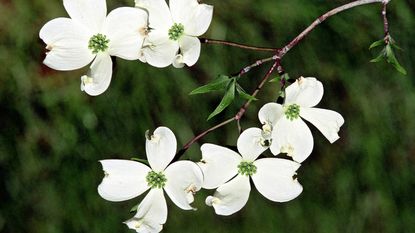My Tree Journey: Flowering Dogwood


My late mom loved trees and respected their role on the earth. She had a small library of tree books, and kept a tree identifier with her when she traveled. I'm living in her old house now, and I can see just how much this love of trees was woven into her life. The property where the house stands is relatively small, but it is full to bursting with trees. Everywhere I look in my new home, I see them -- too many to count, and all of them planted by my mom over the last few decades.
A Special Dogwood Tree
It's no surprise that I've inherited my mother's love of trees. I've always enjoyed gardening, but thanks to her, I also have a deep appreciation for trees, both for their beauty and for the vital role they play in the health of the planet. Trees give us uncountable gifts, most importantly the air we breathe. As I walk among the trees she planted, I feel a deep connection to her, and to the environment.
But there's one that stands out as particularly special to me. My mom's showy and beautiful dogwood tree is close to my heart because it attracts an extraordinary number of pollinators.
Dogwood Blossoms For Pollinators
Dogwoods are spring flowering trees, heralding the arrival of warm weather with an explosion of flowers. This is a welcome sight for us, as it's a sign that winter is finally over. But it's even more welcome to the local wildlife. At any given time during the fabulous bloom season of my mother's dogwood, we can watch bees, butterflies and a number of assorted unidentified flying pollinators (UFPs?) feasting on these bright pink blossoms. Hummingbirds often stop for a snack and occasionally the neighborhood doves and bright finches pay a visit. The intense pink blossoms nod forward almost constantly in a light breeze, and are a stunning sight for human eyes, as well.
Much like the backyard apple blossoms, this towering dogwood seems to have magnetic qualities; neighbors stop on the sidewalk just to spend a few seconds under its beautiful canopy. Like most healthy dogwoods, the tree likes a bit of shade and a bit of sun, and doesn't seem to mind the wretched winter cold or blistering summer heat.
Flowering Dogwood
In the Pacific Northwest, where I live, dogwoods dot the forests and sprinkle the woods with flowers when they bloom, mostly in white but sometimes pink. On family outings we like to spot them glowing under the dark greens of fir and pine stands. Dogwoods in the wild thrive in the dappled sunlight that filters through taller trees.
Some feel the dogwood is symbolic of rebirth. Watching this spectacular tree show off each year in my own yard is something I don't take for granted. For me, it's a link to my past, but it also gives me hope for the future. I think it will probably continue to repeat its billowy performance long after I'm gone.
Gardening tips, videos, info and more delivered right to your inbox!
Sign up for the Gardening Know How newsletter today and receive a free download of our most popular eBook "How to Grow Delicious Tomatoes."
Dogwoods are easy to care for, show-stopping bloomers. If you'd like one of these gorgeous pollinator hubs in your backyard, check out FastGrowingTrees.com, the leading retailer of high-quality trees, shrubs, and perennials.

Caroline Bloomfield is Manager of Marketing Communications at Gardening Know How since 2019. A northwest native, she has resided and gardened in multiple zones in the U.S. and is currently at home in Eugene, Oregon. Writing and editing for various publications since 1998, her BA in American Studies from Southern Maine University includes an emphasis in English. She was raised in California by avid gardeners and continues to enjoy the natural world with an appreciation for the concepts of sustainability and organic care for the planet.
-
 Grow a Bathroom Oasis: 8 Best Bathroom Plants With No Light or Low Light
Grow a Bathroom Oasis: 8 Best Bathroom Plants With No Light or Low LightSome apartment dwellers grow the best bathroom plants with no light or low light. Read how one of our favorite plant lovers does it in the big city.
By Teo Spengler
-
 "My Worst Mistake" – Gardeners Share 10 Hard-Learned Lessons
"My Worst Mistake" – Gardeners Share 10 Hard-Learned LessonsGardeners never stop learning, and sometimes our mistakes are the best teachers. But why not save time and heartache by learning from other gardeners' failures?
By Melanie Griffiths